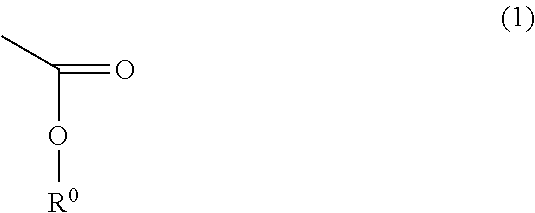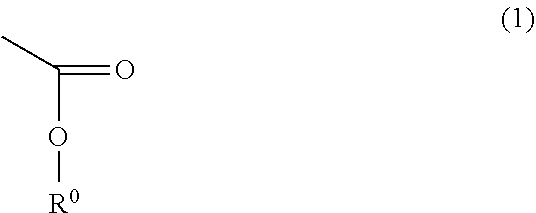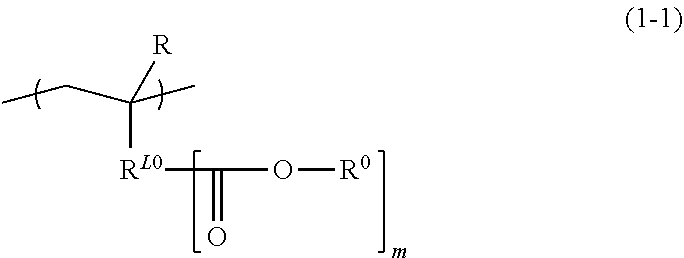Radiation-sensitive resin composition, method for forming resist pattern, and polymer and compound
a technology of resist pattern and resin composition, which is applied in the direction of photosensitive materials, instruments, photomechanical equipment, etc., can solve the problems of complex operation, development defects, and deterioration of surface wettability of a developer and a rinse liquid, so as to reduce dynamic contact angle, shorten time period, and suppress the effect of acid generating agent elution
- Summary
- Abstract
- Description
- Claims
- Application Information
AI Technical Summary
Benefits of technology
Problems solved by technology
Method used
Image
Examples
example 1
Synthesis of 2,4-difluorophenyl-2,2-difluoro-3-(methacryloyloxy)pentanoate (M-1)
[0317]After a reaction vessel which had been sufficiently dried inside by vacuum heating was replaced with dry nitrogen, 100 mL of a solution of 22.22 g (0.1 mol) of 2,2-difluoro-3-(methacryloyloxy)pentanoic acid in dichloromethane was added into the reaction vessel, and the mixture was cooled to an ice temperature. Thereto was added 100 mL of a solution of 22.70 g (0.11 mol) of dicyclohexylcarbodiimide (DCC) in dichloromethane over 10 min, and 0.61 g (5 mmol) of N,N-dimethyl-4-aminopyridine (DMAP) and 13.66 g (0.105 mol) of 2,4-difluorophenol were further added. Thereafter, the temperature of the reaction vessel was elevated to the room temperature, followed by stirring the mixture for 2 hrs, and 300 g of 1 N aqueous hydrochloric acid was added while intimately stirring. Subsequently, a dichloromethane layer was separated by a separatory funnel, and the aqueous layer was extracted again with dichloromet...
example 2
Synthesis of 3-(trifluoromethyl)phenyl-2,2-difluoro-3-(methacryloyloxy)pentanoate (M-2)
[0319]After a reaction vessel which had been sufficiently dried inside by vacuum heating was replaced with dry nitrogen, 100 mL of a solution of 22.22 g (0.1 mol) of 2,2-difluoro-3-(methacryloyloxy)pentanoic acid in dichloromethane was added into the reaction vessel, and the mixture was cooled to an ice temperature. Thereto was added 100 mL of a solution of 22.70 g (0.11 mol) of DCC in dichloromethane over 10 min, and 0.61 g (5 mmol) of DMAP and 17.02 g (0.105 mol) of 3-(trifluoromethyl)phenol were further added. Thereafter, the temperature of the reaction vessel was elevated to the room temperature, followed by stirring the mixture for 2 hrs, and 300 g of 1 N aqueous hydrochloric acid was added while intimately stirring. Subsequently, a dichloromethane layer was separated by a separatory funnel, and the aqueous layer was extracted again with dichloromethane to obtain an extraction liquid. After t...
example 3
Synthesis of 3-(trifluoromethyl)phenyl-2-fluoro-3-(methacryloyloxy)pentanoate (M-3)
[0321]After a 500 mL reaction vessel which had been sufficiently dried inside by vacuum heating was replaced with dry nitrogen, and placed in an ice bath, 24.2 g (370 mmol / 1.5 equivalent) of activated metal zinc and 300 mL of THF (dehydrated) were added into the reaction vessel. Thereto was added a bromofluoroethyl acetate / THF solution (46.91 g (253.6 mmol / 1.0 equivalent) of bromofluoroethyl acetate and 80 mL of THF (dehydrated)) dropwise over 5 min. After the dropwise addition, the temperature of the mixture was elevated to the room temperature, followed by stirring for 20 min. Thereto was added a propionaldehyde / THF solution (17.76 g (305.8 mmol / 1.2 equivalent) of propionaldehyde and 80 mL of THF (dehydrated)), and the mixture was stirred for 60 min at a room temperature. Thereafter, water and diisopropyl ether were added thereto, and two-layer separation was carried out. The organic layer thus obta...
PUM
| Property | Measurement | Unit |
|---|---|---|
| width | aaaaa | aaaaa |
| temperature | aaaaa | aaaaa |
| temperature | aaaaa | aaaaa |
Abstract
Description
Claims
Application Information
 Login to View More
Login to View More - R&D
- Intellectual Property
- Life Sciences
- Materials
- Tech Scout
- Unparalleled Data Quality
- Higher Quality Content
- 60% Fewer Hallucinations
Browse by: Latest US Patents, China's latest patents, Technical Efficacy Thesaurus, Application Domain, Technology Topic, Popular Technical Reports.
© 2025 PatSnap. All rights reserved.Legal|Privacy policy|Modern Slavery Act Transparency Statement|Sitemap|About US| Contact US: help@patsnap.com



